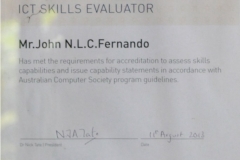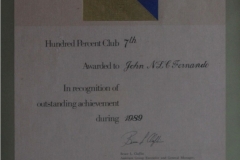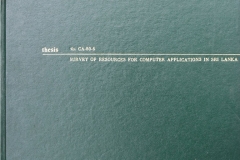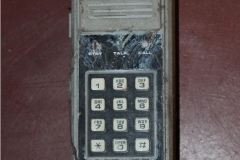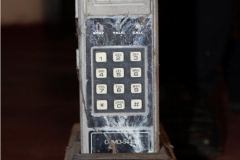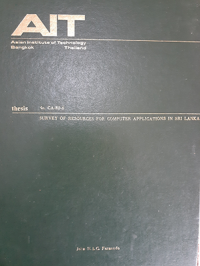Mr. John NLC Fernando was educated at St. Benedict’s College, Kotahena, Colombo and at the Faculty of Engineering at the University of Ceylon, Peradeniya, Sri Lanka. His interest in computers commenced when he was required to carry out an assignment using an Analog computer as a final year engineering student in 1967 at the University.
Mr. Fernando read for a Master’s degree in Computer Applications and Management at the Asian Institute of Technology [AIT] in Thailand in 1979/80 on a Belgian Government Scholarship. His final year Master’s thesis was on the ‘Survey of resources for computer applications in Sri Lanka’. The field work was funded by the University Grants Commission, Sri Lanka and IBM World Trade Corporation. On graduation, Mr. Fernando joined IBM Sri Lanka in late 1980. He has been with for IBM 32 years up to 2012 in various capacities, in India, Hong Kong, Singapore and Sri Lanka, the last four years as a worldwide resource for internal training of IBM staff and literally living off airports.
Mr. Fernando states that his life parallels the history of computing in Sri Lanka from 1968 through initial installations of ICL computers with ICL Ceylon in Sri Lanka, with DMS-Wang mini Computers and later with IBM in Sri Lanka and overseas.
Mr. Fernando, initially from 1967 to 1973 was a Trainee Computer Engineer; then Computer Engineer, and Chief Computer Engineer at ICL Ceylon, and later from 1973 to 1976 was the Computer Engineering Manager at ICL Ceylon in Indonesia. At IBM World Trade Corporation Sri Lanka, he was Trainee Account Rep [Solutions Architect]; Account Rep [Solutions Architect]; and Marketing Manager from 1980 to 1985, Customer Operations Manager from 1988-90; and Country Director {Country General Manager} from 1995 to 1998. Overseas Assignments which included responsibility for Sri Lanka included functioning as Business Planning Manager IBM South East Asia Region from 1986 to 1988, Brand Manager IBM ASEAN – AS/400 from 1993 to 1995, General Business – Brand Advocate IBM Asia Pacific South from 1998-2008, and IBM Worldwide – Sales Learning Facilitator from 2009 to 2012.
He has been a Senior Visiting Lecturer for the Master’s Degree in IT at the Sri Lanka Institute of IT (SLIIT) since 2004. He was also a Founder Director & ex Council Member of the Computer Society of Sri Lanka. Professionally he is a Chartered Engineer, Fellow of the Computer Society and a Fellow of the Singapore Institute of Arbitrators. He is a ACS certified SFIA IT Skills Assessor. He considers himself a world citizen having lived and worked in 8 countries.
Video in Brief
Full Video
The starting point in Mr. John NLC Fernando’s interest in computers was when he was required to carry out an assignment project using an Analog computer as a final year engineering student in 1967 at the University of Ceylon in Peradeniya, Sri Lanka. Mr. Fernando was educated at St. Benedict’s College, Kotahena Colombo and at the Faculty of Engineering at the University of Ceylon, Peradeniya. He says that his father Mr. P.C. Fernando, who was a pioneer Electrical engineer in the UK and in Ceylon had great impact in him choosing mathematics at the Senior Prep [9th grade] which paved the way for an engineering degree. Father knows best.
It was a requirement to obtain the engineering charter to work at an approved engineering establishment, and therefore Mr. Fernando had approached a friend Mr. Anton Samarasinghe, an Accountant at Walker Sons & Company which was an approved Engineering establishment in Sri Lanka. Mr. Samarasinghe had directed him to Office Equipment Ltd [OEL], the sole agent in Sri Lanka for International Computers and Tabulators (ICT later ICL) UK. Walkers’ subsidiary Computer Systems Ltd [CSL] had ordered an ICL computer and OEL was looking for engineering trainees. Mr. Fernando was selected to the post of trainee Computer Engineer through an aptitude test conducted by ICL UK at which he obtained the highest marks worldwide.
ICL CEYLON
He was sent for training in England and later returned to Sri Lanka in 1968. Along with a senior engineer Mr. Bryan Pitawela, he had maintained the ICL 1901S Computer system at State Engineering Corporation [SEC] & another ICL 1901 at CSL/Walkers. Then he installed the ICL 1901A computer at Forde Rhodes associate AMS Data Services Ltd [AMS] Computers in Kollupitiya, Colombo, Sri Lanka.
LARGE and CRITICAL PROCESSING:
These early computers were processing large and critical volumes of data.
Unlike a doctor who can say “the operation was successful, but the patient died”, Mr. Fernando states that as a computer engineer, they had to keep the computer systems going, as otherwise a payroll could not be printed and there would have been a labor strike; or GCE O’ Level results could not be produced and there would have been an uproar, or the Tea export documentation could not be printed and there would have been economic chaos. He recalls two incidents to highlight this. The Line Printer used for payroll and other functions at SEC had packed up, and the diagnosis was found to be a miniature gearbox malfunctioning. Mr. Fernando had gone to an establishment in Deans Road, Maradana which “rigged” taxi meters and there they had fixed it immediately; and the payroll print-out, the pay-slips of thousands of SEC workers were produced instantly. When the AMS ICL 1901A system was being installed the main memory (ferrite core store) was found to be defective [Dead on Arrival]. ICL UK rushed a replacement memory store by air, under warranty for the installation to continue, free of charge. But the documentation accompanying stated that, for customs purposes the value was four thousand English Pounds. Sri Lanka Customs refused to release it initially stating that the memory store was more expensive than a Mercedes Benz car which required a special import license. On appealing to higher authorities’, it was decided that it did not entail transfer of foreign exchange, the memory store was released and the installation successfully completed.
ICL CEYLON in INDONESIA
ICL Ceylon was recognized as being resourceful in this trying period prior to 1977 of successfully maintaining their computers in Sri Lanka without client complaints. They were offered to maintain a large ICL Computer installation at the Central Bureau of Statistics in Jakarta. It consisted of high capacity online document readers to take in directly the census enumeration sheets of a population of 100M. Mr. Fernando, who was then the Chief Computer Engineer ICL Ceylon, was sent for retraining with ICL in England in 1973 and assumed the post of Computer Engineering Manager in Indonesia from 1974-1976. This is an indication that Sri Lanka was ahead of some of the countries in Asia, in Computers.
DATA MANAGEMENT SYSTEMS LTD (DMS)
DMS was the authorized sole dealer for WANG minicomputers in Sri Lanka. He was the founder General Manager of DMS, and was responsible for the sale and installation of the first interactive computer in Sri Lanka – the WANG 2200T to Jafferjee Bros for the processing of the weekly Tea Auction documentation. He received training in Hong Kong on Wang Computers for this purpose.
TERTIARY EDUCATION – AIT
Then he received a Belgian Government scholarship, to do a Master’s degree in Computer Applications and Management at the Asian Institute of Technology [AIT] Thailand 1979/80. His final year Master’s thesis was on the ‘Survey of resources for computer applications in Sri Lanka’. The field work was funded by the University Grants Commission, Sri Lanka and IBM World Trade Corporation, Sri Lanka Branch. The recollection of the early years of computers in Sri Lanka is based on this thesis.
IBM WORLD TRADE CORPORATION
On graduation, he joined IBM Sri Lanka in late 1980. He has been with for IBM 32 years up to 2012 in various capacities in India, Hong Kong, Singapore and Sri Lanka.
CAREER HIGHLIGHTS
Mr. Fernando states that his life parallels the history of computing in Sri Lanka through initial installations of ICL computers with ICL Ceylon in Sri Lanka, with DMS-Wang mini Computers and later with IBM World Trade Corporation in SL and overseas.
ICL Ceylon: Trainee Computer Engineer; Computer Engineer, Chief Computer Engineer 1967-73
ICL Ceylon in Indonesia: Computer Engineering Manager 1973-76
AIT Master’s Scholar: “Survey of Resources for Computer Applications in SL 1979-80
IBM WTC SL: Trainee Account Rep [Solutions Architect]; Account Rep [Solutions Architect]; Marketing Manager; 1980-85 Customer
Operations Manager 1988-90; Country Director {CGM] 1995-98
Overseas Assignments which included responsibility for SL
IBM South East Asia Region – Business Planning Manager 1986-88
IBM ASEAN – AS/400 Brand Manager 1993-95
IBM Asia Pacific South, General Business – Brand Advocate 1998-2008
IBM Worldwide – Sales Learning Facilitator 2009-12
SLIIT – Senior Visiting Lecturer, Masters in IT 2004 – ongoing
CSSL – Founder Director & ex Council Member
CSSL – ACS Accredited SFIA Assessor
Other Posts not relating to Sri Lanka
IBM India Offshore Account Manager – In confidential project team that took IBM back into India 1991
IBM Singapore – AS/400 Brand Manager – 1992
ICT 558 – THE BEGINNING
Mr. Fernando recalls that the first electronic computer system – an ICT 558 – had been installed at Walker and Sons, which had used it for payroll & inventory control work. This was the first electronic computing system and primarily used for accounting. It was under the Chief Financial Officer Mr. Heyhurst FCWA a British citizen, and Mr. Anton Samarasinghe Accountant. The ICT 558 had valves and transistors and had memory stores for Data and Program. It had 40 column card input and output, and used an offline printer to print out the processed results. This machine was maintained by Mr. Renganathan, an ex Police Radio Unit Engineer. Mr. Renganathan of Office Equipment Ltd (OEL) could be considered the first computer hardware Engineer in Sri Lanka.
ICL 1901 – 2nd GENERATION
The second, the first 2nd generation computer, an ICL 1901S with scientific function hardware accelerator, was installed at the State Engineering Corporation [SEC] in 1967. This had transistor logic circuits, magnetic tape drives for online sorting and archival and a high-speed line printer for voluminous printouts. This was the brainchild of Dr. ANS Kulasinghe, Chairman [doyen of the engineering profession], with Prof. Sam Karunaratne as the Data Processing Manager. This computer was used for all the work of this organization, such as accounting using PLAN Assembler, project control using PERT and engineering design using FORTRAN. The core computer team consisted of Mr. Nimal Amerasinghe Senior Scientific Analyst Programmer; Dr. RB Ekanayake, Mr. Ranjan Perera, Mr. Wije, and Mr. F.J. de Silva, all Analyst Programmers. They went onto become the bedrock of computer professionals in Sri Lanka. Since there was excess computer capacity and the staff at the Computer Division were skilled and capable, the SEC undertook projects for other Government organizations. These included processing the results of the GCE Ordinary Level examination for the entire country from 1968 onwards, processing the results of the GCE Advanced Level Examinations, and processing projects of various Government agencies.
The third in 1968 was the ICL 1901 Computer system installed at CSL/Walkers. This 2nd generation computer had transistor logic circuits, paper tape as the input medium. It was envisaged that data would be sent to CSL by its clients using Telex which was on paper tape. CSL was a Data Processing Bureau. It was also used to offload the Walkers data processing work from the older ICT 558.
The fourth computer an ICL 1901A was at AMS Data Services Ltd (AMS), in Kollupitiya, Colombo. The Forde Rhodes Partner in-charge was Mr. D.C. Wijesekera Chartered Accountant. This was a 2nd Generation computer installation with integrated logic circuits [ICs] and was the first to have exchangeable Magnetic Disk drives. AMS was a service bureau operation, and the Company undertook accountancy projects, work relating to tea auctions, etc. Mr. John NLC Fernando recollects that these were the initial computer installations with the ICT 558 at Walkers eventually retired.
3rd GENERATION COMPUTERS
In the next phase from 1969, 3rd generation IBM 360 mainframe computers had been installed at the Insurance Corporation of Sri Lanka [Mr. L.S.A. Fernando and Mr. L.B. Ekanayake], the Ceylon Petroleum Corporation [Mr. Yasa Karunaratne and Mr. Bandu Ranasinghe], and later at the Department of Census and Statistics [Mr. Vithane and Mr. A. Attanayake], the Central Bank of Sri Lanka (where the computer was used to handle the Employees’ Provident Fund) [Mr. Ajit Kanagesunderam & Mr.Tudor Suraweera]. Subsequently, the Examinations Department had also leased an IBM 360 Mainframe computer mainly for in-house processing of the results of the GCE A’ Level and O’ Level examinations. [Mr. Nanayakkara was in-Charge with Mr. Bandu Ranasinghe as an Analyst-Programmer].
SCIENTIFIC COMPUTERS
Mr. John NLC Fernando further states that later additions were the computers at Universities consisting of IBM 1130s at the Faculty of Engineering, University of Peradeniya, under Dr Gunawardane and the Department of Engineering at the University of Moratuwa under Dr Abhaya Induruwa. Three HP Scientific desktop machines were used for statistical work and FORTRAN programming. He recalls that Prof. VK Samaranayake had procured one for the University of Colombo, along with the Postgraduate Institute of Agriculture and Agricultural Research Training Institute (ARTI).
DATA PROCESSING ERAS IN SL
Era-1: Non-computer based Data Processing 1946-1964 POWER SAMAS & HOLLERITH
Era-2 Electronic Computing Machine: 1964-1967 ICT 558
Era-3 2nd Generation Digital Computers: 1967-1968 ICL 1901
Era-4 3rd Generation Digital Computers 1969-1970 IBM 360
Era-5 Lost Computer Generation 1970-1977 IBM 1130
Eria-6 1977 onwards – Conflagration of Desktop, Small Business and Mainframe Computers and early PCs.
DG; HP9825A; IBM5110; IBM S/34; IBM4331; ICL1501; ICL1503; ICL2903; RADIO SHACK; WANG2200; WANG PCS
Era-7 1981 onwards – Advent of IBM Compatible PCs, especially post 1982 the IBM PC with the Charlie Chaplin world-wide
advertising campaign; IBM S/36; IBM AS/400; IBM4361; IBM4381; NIXDORF; UNISYS
Thus, Mr. Fernando recalls that from 1964 to 1967, there was only one computer in Sri Lanka and from 1967 to 1968 there had been three additional ICL computers. From 1969 to 1970 there have been four more IBM computer installations, resulting in a total of 8 Computer installations in Sri Lanka by 1970. He states that from 1970 to 1977 there was a dearth in computer imports to Sri Lanka, as they required foreign exchange which was in short supply. Only two computers for the Universities were allowed to be imported. This, he considers is the lost generation in computers in Sri Lanka.
EARLY COMPUTER APPLICATIONS:
Population Census 12.7 M People; 2,2M Households;
National Provident Fund 3.0M Employees
Examinations 350K Candidates
Warrant Billing 300K Warrants
Insurance 200K Policy Holders
Electricity Billing 175K Customers
Telephone Billing 35K Subscribers
Stock Control SEC 20K Items Rs.38 MRs/ CWE 50K Items Rs.154 MRs
Payroll 12K Employees
Budgetary Control 600 Accounts/3 BRs
PERT SEC Projects
Engineering Design
Engineering Education
Import/Export Reports
Service Bureau Operations
COMPUTERS & GDP
Mr. Fernando explains that there is a relationship between the GDP growth and the computer penetration in a country. With the commencement of the Open Economy in Sri Lanka in 1977, and there being a tax incentive for the acquisition of capital equipment including computers with a reasonable customs duty regime, there was a conflagration in the deployment of computers in Sri Lanka with the private sector buying/leasing small business computers to improve their efficiency and effectiveness. By 1979 the number of computers installed had risen to 33 units with the two early computers at Walkers and its subsidiary CSL retired.
TEA EXPORT PROCESSING
DMS, sole dealer of Wang minicomputer USA where Mr. John NLC Fernando was the Founder General Manager, installed the first interactive computer – a Wang 2200 T – at Jafferjee Brothers Ltd, mainly for processing tea auction data in 1977 – tea being Sri Lanka’s largest export revenue earner during that time. Later Mr. Ruwan Ratnatunge and team had installed more WANG computers with other Tea Exporters, improving the productivity and efficiency of this vital export sector.
COMPUTERS in other VITAL SECTORS of the ECONOMY
MAHAWELI ACCELARTED DEVELOPMENT PROGRAM
River diversion Project. 37 BRs [2.3 BUSD]. Original time estimate of 30 Years cascaded to be completed in 5 years.
125,000 ha irrigable land; Settlement of 1M people. Power generation 400 MW.
- ICL 2903 Computer at Mahaweli Authority used by the Survey Department for land survey calculations; Design; ERIM Remote sensing package.
- WANG 220T used by CECB for design calculations, as they were the primary consultants to Mahaweli Authority
- IBM 4331 Mainframe Computer with FORTRAN Language: Obtained on a CIDA Grant. Running FORTRAN programs for reservoir optimization.
- IBM S/34 used by contractor JV Balfour Beatty – Nuttal at the Victoria Dam site to calculate in real-time the concrete requirements at different points of the double curvature dam.
COMPUTERS in TRADE
Among the early adopters of computers by trading companies are:
- Chemanex [CIC/ICI] IBM S/34 Accounting;
- De Silva, Abeywardane & Peiris ICL 1501 Tea Brokering;
- Free Lanka Trading Company IBM S/34 Accounting;
- Hebtulabhoy WANG 2200 T Tea Auction;
- Jay Kay Computers IBM S/34 Tea Brokering and Accounting of John Keels;
- KG Industries IBM 5110 Accounting, APL Programming Language;
- Lever Bros-Unilever IBM S/34 Accounting;
- Pure Beverages IBM S/34 accounting;
- Sri Krishna Corp IBM S/34 Accounting;
- St Anthony’s Industries IBM S/34 Accounting;
- Stafford Motors- Honda WANG PCS II Customer Order monitoring;
OTHER EARLY USERS
Other early adopters of computers include the following:
- Family Health Bureau – ICL 1503
- Medical Faculty, University of Colombo – ICL 1503
- MSL Computers Ltd associate of Turquand, Young & Co {later Ernst Young] – IBM S/34 Service Bureau
- Sri Lanka Transport Board operates 6000 buses IBM S/34 Provident Fund 60K Employees; Inventory Control 26 MRs of which non-moving items 20 MRs. Payroll 2000 employees.
LATER EFFORTS at COMPUTERISATION
COMPUTERIZATION IN THE BANKING INDUSTRY
Mr. Fernando also recalls the computerization history in the banking sector, which was post 1980; the Peoples Bank had an IBM System/34, a small business computer for loan processing; the Bank of Ceylon [BOC] started with an IBMS/34 to do their important NRFC accounts at the Metropolitan branch. For core banking, they procured an IBM 4331 mainframe to initially computerize three branches. As there were no telephone leased lines available from the Telco, BOC and other clients had to setup their own private dedicated radio links with the support of Mr. B.A.C. Abeywardana, Managing Director, Elektroteks Ltd” who was a Peradeniya University engineer with the required technical skills. BOC then extended this facility to 10 branches.
Mr. Fernando recalls that people responsible for initial computerization in the banking industry had included Mr. Janaka De Silva and Dr. RB Ekanayake, starting at BOC and then at Sampath Bank. He says that the bank which had really made a breakthrough was Sampath Bank under its General Manager, Mr. Janaka de Silva, with Dr. RB Ekanayake as the DGM Data Processing – Sampath Bank’s philosophy was “a client is a client of the bank, and not of a branch.” Therefore, the Bank believed that a client should be able to go to any Sampath Bank branch and transact business. Initially an IBM S/36 computer had been installed at Sampath Bank with a network of private radio links to connect the branches and later upgraded to an IBM 4381 mainframe computer with VSE Operating system and IBM SAFE core banking applications framework. For linking the branches, private radio links with IBM modems had been used for connectivity. The initial line speeds were 1200bps and later upgraded to 2400bps, 4800bps and finally 9600bps when the number of branches connected became large and the data traffic voluminous. A large team of IT professionals under Dr. RB Ekanayake had to do all the application programming. ATM machines had also been installed throughout the branch network. Sampath is the bank, Mr. Fernando states, which had really given the impetus for computerization in the banking sector, and quickly started gaining market-share at the expense of the established banks. This was a classic case of computer technology being used for competitive advantage. Other banks then quickly started catching up by extended their computerization efforts or starting anew. Those which computerized at the early stages had been the Bank of Ceylon [IBM, Nixdorf & Unisys], Commercial Bank [IBM], People’s Bank [IBM & Burroughs] and the Hatton National Bank (NCR & IBM]
AIR LANKA/SRILANKAN AIRLINES
A small business computer, an IBM System/34 machine, had been installed at Sri Lankan Airlines, then known as Air Lanka. Later when the Airline relocated to Katunayake, most of the operations had been computerized using an IBM 4361 mainframe with VM/VSE Operating System. With Rotables Control and Maintenance System for serialized parts such as Landing Gear and Gear boxes and Engines etc. and PROFS for quality and safety documentation maintenance, the first in Sri Lanka. This initiative was headed by Mr. A. Attanayake.
PORTS AUTHORITY
An IBM mainframe IBM 4361 was used at Sri Lanka Ports Authority under Mr. Prasanna Weerasinghe, Chief Engineer and the Chief Accountant for computerizing the commercial operations. This was extended using an IBM RS6000 UNIX computer to automate the entire container handling operation of the port with sensors sending real-time data. The Colombo Port was one of the most advanced in the use of computers in all its operations in South Asia at this time.
COMPUTER EDUCATION
With regard to computer education, in the beginning, when an organization purchased a computer, it was the computer vendor who trained the staff on operating the computer and programming the applications. Therefore, during these initial years, the transfer of knowledge was mainly through the vendors.
Later training on computing had commenced at the National Institute of Business Management (NIBM), under the leadership of Dr. NWN Jayasiri using a WANG 2200 VS. Initially, a Diploma program was offered. This had been highly recognized and the Singapore Immigration had included it as a criterion for employment for working in Singapore. The University of Colombo was conducting FORTRAN language training for the public, under Prof V.K. Samaranayake. Three computer training establishments in the private sector that were instrumental in providing the general public and students, training in computers in the early stages were DP Aides BCS; Global Computers IBM S/34 under Mr. Pathmanathan and follow-on, and IDM under Mr. Bandu Ranasinghe with IBM/ACS.
While the Engineering Faculty at the University of Peradeniya and the Moratuwa University commenced Departments awarding Computer Engineering degrees; the Sri Lanka Institute of Information Technology (SLIIT) was established under Prof Lalith Gamage’s guidance, purely to award degrees in IT.
COMPUTER LANGUAGES
Mr. Fernando states that initially, the commonly used programming language was PLAN/Assembler. Later RPG had been used in IBM small business computers and IBM Mainframes. COBOL was also used and the Universities had used FORTRAN. BASIC was used as it was WYSIWYG [What you see is What you get].
COMPUTER VENDORS
Computer vendors, other than ICL, WANG-DMS and IBM, at which Mr. Fernando had worked, were making a contribution to computing in Sri Lanka. NCR had been supplying data processing equipment primarily to the banks with core banking at HNB, and the ATMs of HSBC and Commercial Bank; Bartleets initially with Radio Shack and later with Unisys had installations at Sri Lanka Telecom et al; Metropolitan with HP and later Canon desktop computers; Informatics under the visionary leader Dr. Gamini Wickremasinghe with Nixdorf computers from Germany.
OTHER COMPUTER RELATED PLAYERS
Coverage of the advent of computers in Sri Lanka has to include the firm A-Z Computers [with Dr. Maya Sittampalam Rainford and Mr. Rainford] who used to develop software on Burroughs computers and assemble mother boards for export; Jagath Robotics owned by Mr. Jagath Ranawaka; A Firm Computerlink run by Mr. Reggie Candappa’s [doyen of the Advertising Agencies] son-In-Law Mr. Zarook Marrikar and EDS International led by Mr. Mohan Wijekoon who had a software development establishment based in Sri Lanka, and used Sri Lankan IT talent to support their operations in South East Asia headed by Mr. John Salmon and Mr. Carlyle Edwards. Since there were no dedicated telephone lines available to link the branches of large organizations, especially the banks, private radio links supplied by Mr. B.A.C Abeywardena of Eltroteks Ltd with IBM modems had been used for connectivity. All computer installations had voltage stabilizers and battery powered Uninterrupted Power supply (UPS) systems for orderly shut-down and some which had mission critical applications had generator backup.
PROFESSIONALISM in COMPUTING
One of the most important aspects he would like to record is the formation of the Computer Society of Sri Lanka (CSSL) to give recognition to computer professionals. Engineers such as Mr. John NLC Fernando, Science graduates and people with an accountancy background formed the core group of those who were employed in the computer installations, and at the computer vendors. Then a group of those in the computer profession, namely Dr. R.B. Ekanayake [SEC], Mr. Nanayakkara [Exams Department], Mr. Vithane [Census Department], Mr. A. Attanayake [Census/Srilankan Airlines], Ms. Nayeni Fernando [Census Dept/Central Bank], Ms. Perera [Census Dept /AMS], Mr. Yasa Karunaratne [Petroleum Corporation/ETFB], Mr. Bandu Ranasinghe [Petroleum/IDM], Mr. Ranjan Perera [SEC/BOC/SLPA], Mr. Ruwan Ratnatunga [AMS/DMS] Mr. Kanishka Sugathadasa [ANCL/Mahaweli Authority], Dr. NWN Jayasiri [NIBM] rallied together to form the CSSL.
CSSL used to conduct the Annual National Computer Conference with participation of Computer Professionals from across the industry; and run the annual computer exhibition sponsored by the participating computer vendors. This was popular with school students to get a glimpse of the future and careers in computing. Later CSSL started the popular Schools computer software contest.
Mr. Fernando recalls getting standard computer education available to Sri Lankan students by inviting the Australian Computer Society (ACS) to conduct their exams in Sri Lanka. He under-studied the ACS representative in approving Computer Training Institutes and later was responsible for this task in Sri Lanka.
CINTEC
The Computer and Information Technology Council of Sri Lanka (CINTEC) which was later named the Council for Information Technology was established as the Apex Government body on computers and IT and to provide a focal point for policy formulation for the Government. Prof V.K. Samaranayake was a familiar figure who took over the chairmanship of CINTEC from his predecessor, Prof. Mohan Munasinghe. Prof. Samaranayake with stakeholders established associations for various computer segments. Mr. Fernando representing IBM was the first chairman of the Sri Lanka Computer Vendors Association (SLCVA), with Mr. Jit Warnakulasuriya as the vice chairman. SLCVA used to run public awareness seminars monthly at lunch time in 5* hotels.
PAST CHALLENGES – FUTURE OPPORTUNITIES
Mr. Fernando is of the view that the ICT industry at present is unaware of the initial efforts and the tremendous challenges and impediments that had to be overcome. Sri Lankans with their high literacy rate, ability to absorb new technology and being resourceful have risen to the many challenges.
He states that the next stage is big data and analytics; that is the way in which intelligence can be made out of the huge mass of data that is available through social media etc., and using it for decision making and policy formulation by the Government, the private sector and commercial entities. He also states today it is difficult to get people to do mundane and routine jobs, and therefore robotics and artificial intelligence is important. Unlike in the past when each establishment had a computer in their premises with skilled IT professionals, the future would be computing as a service on the cloud, much like telephone and email, with professionals with skilled domain knowledge at each establishment or available as consultants. The use of the Internet for telecommuting, rather than actual commuting causing traffic jams would make it convenient for parents to look after their children, and people to look after aged parents; the use of virtual classes for life-long learning; the use of remote medical diagnostics by consultants to improve the well-being of our rural society; are some of the areas that could be utilized and further strengthened. The future for youth in ICT is promising and Mr. John NLC Fernando is of the view that this should be used in their day to day lives.
REFERENCES:
1. Master’s Thesis No. CA-80-6 “Survey of Resources for Computer Applications in Sri Lanka”, John N.L.C. Fernando, Computer Applications Division, Asia Institute of Technology (AIT), Bangkok, Thailand August 1980
2. Unpublished Manuscript “Computing in Sri Lanka” John NLC Fernando, 1980
John NLC Fernando,
IBM QCC
Dip Law London; BSc Eng Cey; MEng AIT
FSIArb, FCS, MACS, CEng, MIE.
Copyright John NLC Fernando vJF1.1
Gallery
Resources
Thesis “Survey of Resources for Computer Applications in Sri Lanka” by Mr. John NLC Fernando, in partial fulfillment of the requirements of the Master of Engineering, Asian Institute of Technology (AIT), Bangkok, Thailand. 1980
Copyright: John NLC Fernando


